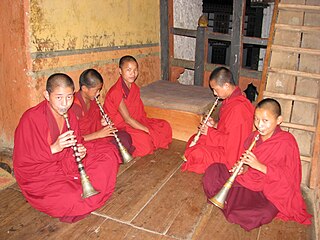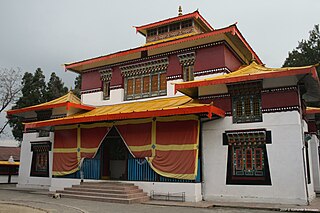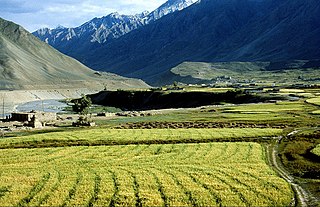Related Research Articles

Arunachal Pradesh is a state in Northeast India. It was formed from the erstwhile North-East Frontier Agency (NEFA) region, and became a state on 20 February 1987. It borders the states of Assam and Nagaland to the south. It shares international borders with Bhutan in the west, Myanmar in the east, and a disputed border with China in the north at the McMahon Line. Itanagar is the state capital of Arunachal Pradesh. Arunachal Pradesh is the largest of the Seven Sister States of Northeast India by area. Arunachal Pradesh shares a 1,129 km border with China's Tibet Autonomous Region.

The music of Bhutan is an integral part of its culture and plays a leading role in transmitting social values. Traditional Bhutanese music includes a spectrum of subgenres, ranging from folk to religious song and music. Some genres of traditional Bhutanese music intertwine vocals, instrumentation, and theatre and dance, while others are mainly vocal or instrumental. The much older traditional genres are distinguished from modern popular music such as rigsar.

The Monpa or Mönpa is a major tribe of Arunachal Pradesh in northeastern India. The Tawang Monpas have a migration history from Changrelung. The Monpa are believed to be the only nomadic tribe in Northeast India - they are totally dependent on animals like sheep, cow, yak, goats and horses. The Monpa have a very close affinity with the Sharchops of Bhutan. Their languages are Tibeto-Burman languages written with the Tibetan alphabet.

Tsangyang Gyatso was the 6th Dalai Lama. He was an unconventional Dalai Lama that preferred the lifestyle of a crazy wisdom yogi to that of an ordained monk. His regent was killed before he was kidnapped by Lha-bzang Khan of the Khoshut Khanate and disappeared. It was later said that Tsangyang Gyatso visited China and meditated for six years in a Chinese Buddhist monastery called ༼རི་བོ་རྩེ་ལྔ་༽. Later, Mongolians took him to Mongolia, where he died at the age of 65 at one of the biggest Tibetan Buddhist monasteries in Mongolia. There is a stupa to him there.

The Gẹlẹdẹ spectacle of the Yoruba is a public display by colorful masks which combines art and ritual dance to amuse, educate and inspire worship. Gelede celebrates “Mothers”, a group that includes female ancestors and deities as well as the elderly women of the community, and the power and spiritual capacity these women have in society. Focusing not only on fertility and motherhood but also on correct social behavior within the Yoruba society.
Losar also known as Tibetan New Year, is a festival in Tibetan Buddhism. The holiday is celebrated on various dates depending on location tradition. The holiday is a new year's festival, celebrated on the first day of the lunisolar Tibetan calendar, which corresponds to a date in February or March in the Gregorian calendar. In 2020, the new year commenced on the 24th of February and celebrations ran until the 26th of the same month. It also commenced the Year of the Male Iron Rat.

The Enchey Monastery was established in 1909 above Gangtok, the capital city of Sikkim in the Northeastern Indian state. It belongs to the Nyingma order of Vajrayana Buddhism. The monastery built around the then small hamlet of Gangtok became a religious centre. The location was blessed by Lama Drupthob Karpo, a renowned exponent of tantric (adept) art in Buddhism with flying powers; initially a small Gompa was established by him after he flew from Maenam Hill in South Sikkim to this site. The literal meaning of Enchey Monastery is the "Solitary Monastery". Its sacredness is attributed to the belief that Khangchendzonga and Yabdean – the protecting deities – reside in this monastery. As, according to a legend, Guru Padmasambhava had subdued the spirits of the Khangchendzonga, Yabdean and Mahākāla here. In view of this legend, the religious significance of Enchey Monastery is deeply ingrained in every household in Gangtok. It is also believed that these powerful deities always fulfil the wishes of the devotees.

Tibet developed a distinct culture due to its geographic and climatic conditions. While influenced by neighboring cultures from China, India, and Nepal, the Himalayan region's remoteness and inaccessibility have preserved distinct local influences, and stimulated the development of its distinct culture.

Sera Monastery is one of the "great three" Gelug university monasteries of Tibet, located 1.25 miles (2.01 km) north of Lhasa and about 5 km (3.1 mi) north of the Jokhang. The other two are Ganden Monastery and Drepung Monastery. The origin of its name is attributed to a fact that during construction, the hill behind the monastery was covered with blooming wild roses.

Tibetan cuisine includes the culinary traditions and practices and its peoples. The cuisine reflects the Tibetan landscape of mountains and plateaus and includes influences from neighbors. It is known for its use of noodles, goat, yak, mutton, dumplings, cheese, butter, yogurt, and soups. Vegetarianism has been debated by religious practitioners since the 11th century but is not prevalent due to the difficulty of growing vegetables, and cultural traditions promoting consumption of meat.

Rizong gompa, Gelugpa or Yellow Hat Buddhist monastery is also called the Yuma Changchubling in Ladakh, India. It is situated at the top of a rocky side valley on the north side of the Indus, to the west of Alchi on the way to Lamayuru. It was established in 1831 by Lama Tsultim Nima under the Gelukpa order, at Ri-rdzong. There are 40 monks in the monastery. The monastery is also called "the paradise for meditation" and is noted for its extremely strict rules and standards. The nunnery, located about 2 km from the monastery, is called the "Jelichun Nunnery" or Chulichan (Chomoling), where, at present, 20 nuns reside.

Karnataka has a variety of traditional arts, including folk dance and puppetry.

Thikse Gompa or Thikse Monastery is a gompa affiliated with the Gelug sect of Tibetan Buddhism. It is located on top of a hill in Thiksey approximately 19 kilometres (12 mi) east of Leh in Ladakh, India. It is noted for its resemblance to the Potala Palace in Lhasa, Tibet, and is the largest gompa in central Ladakh, notably containing a separate set of buildings for female renunciates that has been the source of significant recent building and reorganisation.

Lhamo, or Ache Lhamo, is a classical secular theatre of Tibet with music and dance that has been performed for centuries, whose nearest western equivalent is opera. Performances have a narrative and simple dialogue interspersed with comedy and satire; characters wear colorful masks. The core stories of these theatrical plays are drawn mostly from ancient Indian Buddhist folk tales, lives of important people and historical events from Tibetan civilization. However the ceremonial, dance and ritual spectacles strongly reflects the Tibetan Royal Dynastic period.

Korzok, is a Tibetan Buddhist monastery belonging to the Drukpa Lineage. It is located in the Korzok village, on the northwestern bank of Tso Moriri (lake) in Leh District, Ladakh, India. The gompa (monastery), at 4,560 metres (14,960 ft), houses a Shakyamuni Buddha and other statues. It is home to about 70 monks.

Karsha Monastery or Karsha Gompa is a Buddhist monastery in the Padum Valley of the Zanskar region of the union territory of Ladakh in northern India. The Doda River flows past the monastery from its source at the Drang Drung glacier of the Pensi La. It was founded by the translator, Phagspa Shesrab. The monastery, also known by the name "Karsha Chamspaling’, was founded by Phagspa Shesrab, under the Gelugpa Order or the Yellow Hat Order.

Tawang Monastery, located in Tawang city of Tawang district in the Indian state of Arunachal Pradesh, is the largest monastery in India. It is situated in the valley of the Tawang Chu, near the small town of the same name in the northwestern part of Arunachal Pradesh, in close proximity to the Chinese and Bhutanese border.

Likir Monastery or Likir Gompa (Klud-kyil) is a Buddhist monastery in Ladakh, Northern India. It is located at 3700m elevation, approximately 52 kilometres (32 mi) in the west of Leh. It is picturesquely situated on a little hill in the valley, in Likir village near the Indus River about 9.5 kilometres (5.9 mi) north of the Srinigar to Leh highway. It belongs to the Gelugpa sect of Tibetan Buddhism and was established in 1065 by Lama Duwang Chosje, under the command of the fifth king of Ladakh, Lhachen Gyalpo (Lha-chen-rgyal-po).

The Gongkar Chö Monastery or Gongkar Dorjé Monastery is located in Gonggar County, Lhoka Province, Tibet Autonomous Region near Gonggar Dzong and Lhasa Gonggar Airport.
The Sangken festival is celebrated in Arunachal Pradesh and parts of Assam, India, as the traditional New Year's Day from 14 to 16 April by the Theravada Buddhist Communities. It coincides with the New Year of many calendars. The Sangken festival is celebrated by the Khamti, Singpho, Khamyang, Tangsa tribes of Arunachal Pradesh, and Tai Phake, Tai Aiton, and Tai Turung communities of Assam. Sangken generally falls in the month of 'Nuean Ha', the fifth month of the year of the Tai lunisolar calendar coinciding with the month of April. It is celebrated in the last days of the old year and the New Year begins on the day just after the end of the festival.
References
- 1 2 Kohli 2002, p. 328.
- 1 2 3 4 Pathak & Gogoi 2008, p. 27-30.